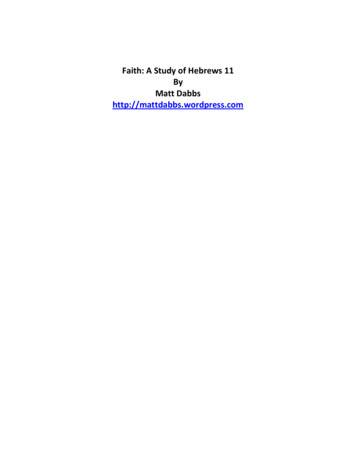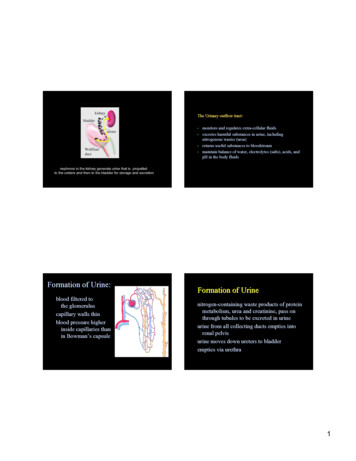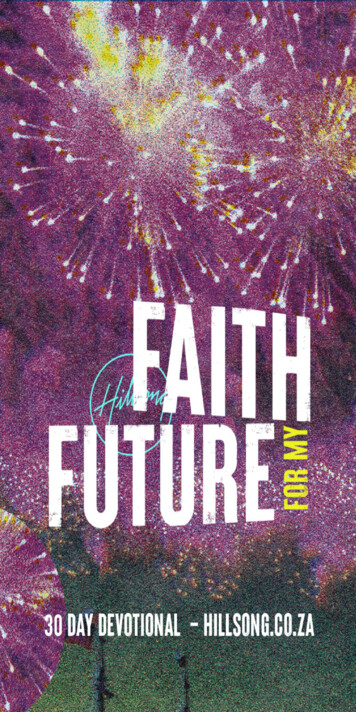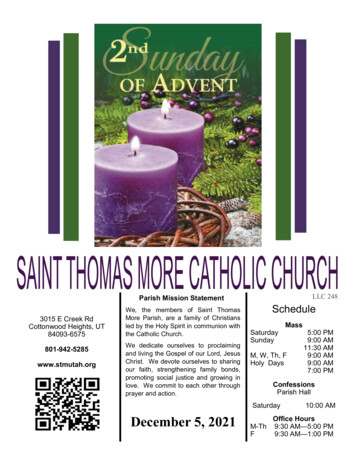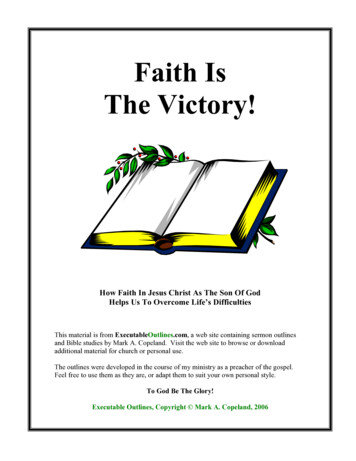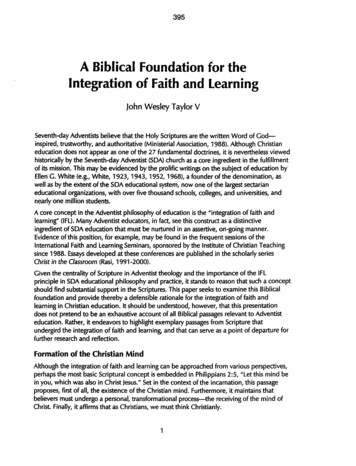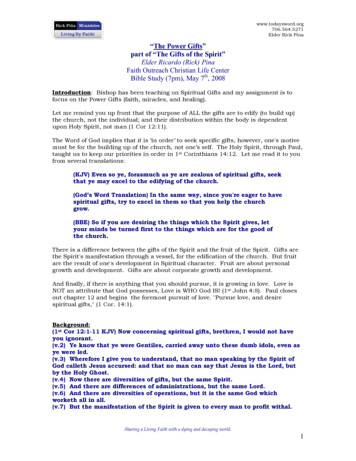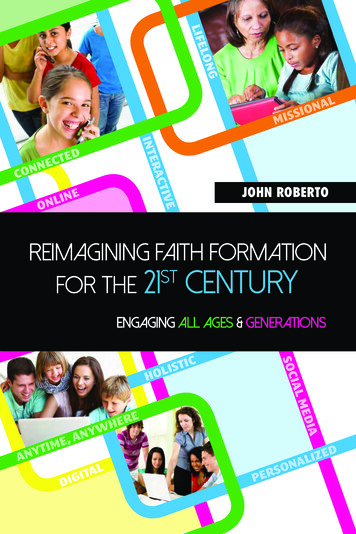
Transcription
OHN ROBERTOVEIONLREIMAGINING FAITH FORMATIONSTFOR THE 21 CENTURYOKEBOEngaging All Ages & ISTLOHDIZELASONREP
Reimagining Faith Formation for the 21st Century:Engaging All Ages & GenerationsCopyright 2015 LifelongFaith Associates. All rights reserved. Except for brief quotations in critical articles or reviews, no part of this book may be reproduced in any manner without permissionfrom the publisher. For reprint permission contact LifelongFaith Associates at jrlifelong@gmail.com.Cover and book design: Hillspring Books, Inc.Publishing consultant: Huff Publishing Associates, LLCScripture quotations are from New Revised Standard Version of the Bible, copyright 1989, Division of Christian Education of the National Council of Churches in the United States of America.ISBN 978-0-9823031-6-0Lifelong Faith PublicationsLifelongFaith Associates40 Brighton RoadNaugatuck, CT 06770www.LifelongFaith.com
CONTENTSIntroduction 1CHAPTER ONEInterpreting the Challenges 5CHAPTER TWOReimagining the Vision 31CHAPTER THREEReimagining the Model 57CHAPTER FOURReimagining the Curriculum 83CHAPTER FIVEReimagining the Resources 121Assessment Tool and Online Resources 134
introductionWhat does it mean to reimagine? Dictionaries define it to “reinterpret imaginatively,”“rethink,” “imagine again or anew,” “form a new conception of,” or “recreate.”Reimagining Faith Formation for the 21st Century is true to these definitions. In thisbook I rethink and recreate faith formation for a twenty-first century world. In sodoing, I am proposing a “new conception” of faith formation that is faithful to ourcontinuing mission of making disciples and promoting lifelong growth in faith—designed for people in the twenty-first century.I believe we are at the dawn of a revitalization of the church’s educational andformational ministry. I believe we can embrace new approaches that provide faithformation for all ages and generations in our faith communities and out in the world.I believe we are blessed with new thinking about learning and faith formation, andan abundance of new resources and digital media and technologies that can transformthe way we do faith formation.This book is a proposal for what twenty-first century faith formation can looklike. Much has been written about the challenges facing Christianity and faith formation. This book seeks to provide a way forward. It reflects a decade of my thinkingand conceptualizing and innovating. It reflects what I am learning from churches thatare embracing twenty-first century approaches.This book is also a “how to” for faith formation: How to address big adaptivechallenges facing churches and faith formation? How to reimagine faith formationwith a vision that honors the past and is open to the future? How to build a newfaith-forming ecosystem that supports faith transmission and growth? How to designnew models with the best understandings and practices of learning and faith formation? How to engage all people—wherever they may be on their spiritual journey?Chapter 1 explores four big adaptive challenges facing churches and faith formation to identify the need for a new faith-forming ecosystem and new models of faithformation. These four challenges include:1.increasing diversity throughout American society in the length of the lifespan, in generational identities, in family structures and marriage patterns,and in the ethnic makeup of America1
2Reimagining Faith Formation2.rise of new digital technologies that are reshaping society, and the emergence of a connected, networked society3.dramatic changes and increasing diversity in the religious beliefs, practices,and affiliation of Americans4.decline in religious transmission from generation to generationChapter 2 presents a reimagined faith formation ecosystem for the twenty-firstcentury. For more than one hundred years in the United States, Christian churcheshad a highly integrated religious ecosystem. It was comprised of multigenerationalfamily faith practice and religious transmission at home; strong congregational community relationships and church life, especially participation in Sunday worship;weekly Sunday school for children and youth (and in many cases adults); and churchgroups (youth, men, women). Many Christian traditions relied heavily on the ethnicfaith traditions of their people to transmit faith from generation to generation—athome and at church. And all of this was surrounded by a culture that explicitly orimplicitly supported the Christian value system and practices.There is no way to go back to this older ecosystem. The new ecosystem I propose incorporates five, essential, interconnected components:1.intergenerational faith formation in the congregation2.age-group and generational faith formation in a variety of physical placesand online spaces3.family faith formation at home4.missional faith formation to the spiritual but not religious and the unaffiliated5.online and digitally enabled faith formationChapter 3 presents a reimagined model of faith formation as a network ofrelationships, content, experiences, and resources—in physical places and onlinespaces. This networked model of faith formation is lifelong—each stage of life frombirth to death—and life-wide—everywhere, anytime learning within a network ofmentors, teachers, family, and peers. It provides a wide variety of engaging andinteractive content and experiences in online and physical settings (home, congregation, community, world). It offers faith formation content and experiencesto respond to the diverse religious and spiritual needs of people today—from thespiritually committed and engaged to the spiritual but not religious and the unaffiliated. It enables congregations to become centers for lifelong learning and faithgrowth for all people by utilizing the best of the new digital technologies to bringan abundance of meaningful and engaging faith-forming experiences—in the congregation and the world, and in a variety of media—to people of all ages.
IntroductionChapter 4 presents a reimagined understanding of faith formation curriculum as a lifelong journey of discipleship—a process of experiencing, learning, andpracticing the Christian faith as we seek to follow Jesus and his way in today’sworld. I propose eight characteristics or features of a lifelong faith formation curriculum that reflect our continuing mission, the new faith formation ecosystem,and a contemporary approach to learning. This chapter includes a ten-step processfor designing a curriculum that supports these features and is built on a networkmodel of learning.1.Holistic: envisioning Christian faith as a way of the head, the heart, and thehands—informing, forming, and transforming people in faith and identity.2.Comprehensive and balanced: developed around the eight primary faith-formingprocesses that facilitate faith growth and incorporate essential knowledgeand practices of the Christian faith: caring relationships; celebrating liturgical seasons; celebrating rituals and milestones; learning the Christian tradition and applying it to life; praying and spiritual formation; reading theBible; serving people in need, working for justice, and caring for creation;and worshipping God with the faith community.3.Systemic: providing a curriculum for the new faith-forming ecosystem—anintergenerational faith formation curriculum centered in church life andevents, an age-group and generational faith formation curriculum, a familyfaith formation curriculum for the home, and a missional faith formationcurriculum for the spiritual but not religious and the unaffiliated.4.Lifelong: spanning ten decades of life and addressing the uniqueness of eachstage of life.5.Contextual: addressing the needs, hungers, interests, and concerns of people today and their unique spiritual and faith journeys by embracing anapproach that moves from life to faith to life.6.Digitally enabled: complementing the gathered community settings withonline learning environments and utilizing the abundance of digital mediaand tools for learning and faith formation.7.Connected: linking church life, age groups/generations, daily/home life, andonline life through continuous faith formation—connecting participationin church life and events with daily/home life by using online content andconnections or reaching people at home and in daily life with online faithformation content and experiences that connect to church life and events.8.Multi-platform: delivered and conducted in multiple settings—self-directed,mentored, at home, in small groups, in large groups, church-wide, in thecommunity and world—and in physical and online learning environments.3
4Reimagining Faith FormationChapter 5 reimagines the role of faith formation leader as a curator. In thenew world of abundant resources, the role of the faith formation leader is shiftingfrom providing religious content and programming to curating religious content andexperiences for all ages. A faith formation curator is a trusted guide who continually finds, groups, organizes, and connects the best and most relevant content andresources on a specific subject to match the needs of a specific audience. This chapter describes the importance of curation and how to curate high-quality resourcesfor faith formation using a four-step process:1.research and organize resources2.identify potential resources for the curriculum3.evaluate resources4.connect the resources to programmingFinal thought. We are at the beginning of a journey toward twenty-first century faith formation. This book seeks to be a first word in what I believe will be anew era for faith formation. Yet beginnings can be fearful, letting go of old waysof thinking and acting can very difficult, and embracing innovation and experimentation can be challenging. But this is what is required of us today. If we arewilling to embrace the opportunities in reimagining faith formation, we can makea real difference in the lives of children, youth, young adults, adults, families, andthe whole congregation.I would like to close with these words from Seth Godin, written a day after thedeath of Nelson Mandela. They are words of inspiration and motivation for all of us.Others can better write about Nelson Mandela’s impact on the worldstage, on how he stood up for the dignity of all people and on how hechanged our world.For those that seek to make a change in the world, whether global orlocal, one lesson of his life is this:You can.You can make a difference.You can stand up to insurmountable forces.You can put up with far more than you think you can.Your lever is far longer than you imagine it is, if you choose to use it.If you don’t require the journey to be easy or comfortable or safe, youcan change the world.(Seth Godin, “Legacy of Mandela,” http://sethgodin.typepad.com/seths blog/2013/12/a-legacy-of-mandela.html)
chapter 1interpreting the challengesWe all know the world is changing around us. We experience it every day. Sometimes we embrace particular changes and innovations and integrate them into ourdaily lives. At other times we are confused, fearful, and overwhelmed by the pace andenormity of the changes and wonder what impact they will have on us, our family,our community, and our future.Religious congregations and their leaders experience the same changing world andrespond in similar fashion—embracing and integrating some changes while beingconfused, fearful, and overwhelmed by others.Some congregations deny that the changes are really happening or affecting themand continue to do “business as usual.” Many others respond by putting more energyand resources into “tried and true” programs or projects, developed in an earlier era,to address the changing world only to be disappointed and discouraged when theydon’t produce the desired results. A smaller group of congregations and their leadersdecide to reimagine church life and faith formation in the new world, developingnew initiatives and projects.Faith formation is contextual—the models, approaches, resources, and technologies we use are suited to particular eras. The schooling model of education in thetwentieth century became the dominant paradigm for church education as congregations organized Sunday school classes by grade level, in school-like settings, withtextbooks developed for grade levels or age groups, in one-hour sessions organizedaround the school year calendar, and so on. Youth groups and adult education followed a similar pattern. Sunday school and its variations became the dominant paradigm for congregational education.5
6Reimagining Faith FormationFaith formation is contextual—it relies on the surrounding ecology for supportand reinforcement. The twentieth-century model assumed a supportive (multigenerational) family faith practice and socialization, a supportive church culture, andpeople’s participation in church life, especially Sunday worship. It relied on a wholeecology of faith-forming people and activities to support the hourly programming.Many Christian churches relied on the ethnic faith traditions of their people totransmit faith from generation to generation—at home and church.Consider this: If someone had been away from church for fifty years and walkedinto a typical church education program today, they might feel right at home:classes organized by age group, textbooks, small groups, and youth group; scheduled on a weekly basis between September and May; and held at a church facility.Except for schools, in what other setting would people feel so familiar and comfortable after a fifty-year absence? It seems that far too many congregations assumethat the educational models inherited from an earlier era still address the real livesof people in the twenty-first century.We need to ask ourselves: Are the twentieth-century models up to the challengeof the twenty-first century world and its people? Are these older forms of faithformation sustainable today? What would new forms of faith formation, suited totwenty-first century people and life, look like? How can we develop adaptive andinnovative initiatives that address the new context and enable us to provide vibrantfaith formation for all ages and all generations in the twenty-first century?Churches today face a huge adaptive challenge in developing faith formationfor the twenty-first century. One way to frame this adaptive challenge is to imagine what faith formation in a congregation would look like if we “started fromscratch.” What models and approaches would we use? What types of faith formation opportunities would we offer? When? For whom? Where? What resourceswould we need? What technologies would we use?This first chapter sets the context for faith formation in the twenty-first century. At the beginning of the 2010s, the book Faith Formation 2020: Designing theFuture of Faith Formation identified driving forces that would most directly impactthe future of faith formation in Christian churches and the ability of churches toprovide vibrant faith formation for all ages and generations. These included:1.growing number of people who were religiously unaffiliated and spiritualbut not religious2.declining participation in Christian churches3.increasing diversity and pluralism in American society4.increasing influence of individualism on Christian identity and communitylife5.changing patterns of marriage and family life6.declining religious socialization
Interpreting the Challenges7.increasing impact of digital media and web technologiesAs we now enter the second half of the decade, it appears that each of thesetrends has increased in importance and actually accelerated in its impact.This chapter builds on the work of Faith Formation 2020 by focusing on four,interconnected and significant adaptive challenges facing churches and faith formation today and into the future:1.increasing diversity throughout American society in the length of the lifespan, in generational identities, in family structures and marriage patterns,and in the ethnic makeup of America2.rise of new digital technologies that are reshaping society and the emergence of a connected, networked society3.dramatic changes and increasing diversity in the religious beliefs, practices,and affiliation of Americans4.decline in religious transmission from generation to generationThis chapter describes each of these challenges, providing research and analysis and identifies questions to help us frame the adaptive challenges facing us.Responding to these four adaptive challenges will launch leaders on a journey oflearning, discovery, innovation, and experimentation—all directed toward twentyfirst century faith formation that helps all people develop a vibrant and life-transforming relationship with Jesus Christ. How congregations respond to these fourchallenges will, in large part, determine the future shape of church life in America.The rest of the book is devoted to developing approaches to address these majoradaptive challenges and help faith formation for all ages and generations thrive inthe twenty-first century.CHALLENGE: INCREASING DIVERSITYIN AMERICAN SOCIETYVery few congregations are designed to address heterogeneity—diverse populationsof people. Most congregations were designed for a homogeneous world where people were more alike than different. In the past one hundred years, congregationshave been built around a particular ethnic community, a particular neighborhoodor geography, a particular demographic (such as families or a particular generation),and so on. Faith formation followed this example and designed programming thatmade assumptions about the people they were serving: children come from twoparent homes, with same-faith parents, who are practicing their faith and attendingSunday worship.7
8Reimagining Faith FormationWhat happens when the social landscape changes? We are seeing the emergenceof a ten-decade life-span, a five-generational society, an ethnically diverse societyand church, ten family forms, and the decline of marriage. How well is congregational faith formation designed to address this new diversity? How many faithformation programs are based on outdated understandings of the people in theircongregation and wider community?The Ten-decade Life-spanWe can now talk about a ten-decade perspective on the life-span. According toprojections from the United States Census Bureau, the population ages sixty-fiveand older is expected to more than double between 2012 and 2060, from 43.1 million to 92.0 million, representing just over one in five US residents by the end ofthe period, up from one in seven today. Again according to the Census Bureau, in2014 children ages 0–18 were 25 percent of the US population; adults ages 19–64were 61 percent; and adults ages 65 and older were 14 percent.The Five-generational SocietyThere are now at least five distinct generations in America: the builder (or silent)generation (born before 1946), the baby boomer generation (1946–1960/64), generation X (1961/64–1979), the millennial generation (1980–1999), and the iGeneration(2000–). Generations have unique and distinctive identities that can be describedby their relationship to institutions, relationship to authority, family relationships,work-life balance, communication styles, technology usage, learning styles, religiousexpression, and more. For example, in a Pew Research survey on “What makes yourgeneration unique?” the generations described several key features of their own generation, ranked in order starting with most important (Taylor, 34).Silent/BuilderBaby BoomerGeneration XMillennialWW II/DepressionWork ethicTechnology useTechnology useSmarterRespectfulWork ethicMusic/pop k ethicValues/morals“Baby Boomers”Smarter
Interpreting the ChallengesBut these differences don’t make for conflict. In fact, most Americans do not seedifferences between generations as a source of friction. The generation gaps that doexist focus more on the differences in the use of technology and lifestyles.An Ethnically Diverse Society and ChurchThe United States is fast becoming a plurality nation, which means that no ethnicgroup will be more than 50 percent of the population. According to the latest(2012) United States Census Bureau report, there will no longer be a majority group as the non-Hispanic white population decreases in number while stillremaining the largest single group.By 2060 the percentage of white alone (non-Hispanic) Americans will declinefrom 63 percent to 43 percent; Hispanic Americans will rise from 17 percent to31 percent; the black Americans population will rise to 15 percent; and the AsianAmericans population will rise to 8.2 percent. The number of two or more raceAmericans will rise from 2.4 percent to 6.4 percent.In “Changing American Congregations” (2014) Mark Chaves reports thatAmerican congregations have become more ethnically diverse since 1998.A key point is that although the population of congregations has itselfbecome somewhat more diverse—for example, 7.7 percent of churchgoers attended predominantly Hispanic congregations in 2012 compared toonly 1.4 percent in 1986—there also is meaningful change within congregations. Congregations, especially predominantly white congregations,have become more internally diverse since 1998. . . . The percentage ofpeople attending congregations in which no ethnic group constitutes atleast 80 percent of the regular attendees increased from 15.3 percent in1998 to 19.7 percent in 2012. This is a steady and notable increase in thepercent of congregations in which no one group has an overwhelmingmajority of the people. . . .Today’s predominantly white congregations are less predominantlywhite than they were in 1998. The percent of attendees in congregationswith at least some Latinos, Asians, or African Americans has increasedsteadily since 1998. In 2012, clear majorities of churchgoers in predominantly white congregations were in congregations with at least someblacks (69 percent) or Hispanics (61.7 percent), and almost half (48 percent) were in congregations with at least some Asians (Chaves, 2014, 7).Chavez cautions that 86 percent of American congregations (containing 80 percentof religious service attendees) remain overwhelmingly white or black or Hispanic orAsian or whatever. However, there is noticeable change in a more diverse direction.9
10Reimagining Faith FormationDiverse Family Forms and the Decline of MarriageThere is an expanding understanding of what constitutes a family today and a corresponding growth in the variety of family structures in America—kindred families,and non-kindred “families” who live in shared households with a depth and intimacy of relationships and support. We can count at least ten kindred family forms:1.married couple with children (original biological family)2.married couple with children (blended family)3.single parent with children4.unmarried couple with children5.unmarried couple without children6.same-sex couple with children (married or unmarried)7.same-sex couple without children (married or unmarried)8.grandparents and parents with children9.grandparents as primary caregivers of children10. parents with single young adults living at homeToday, among 100 representative children, just 22 live in a married male-breadwinner family, compared to 23 living with a single mother (only half of whomhave ever been married). There are 7 living with a parent who cohabits with anunmarried partner (a category too rare for the Census Bureau to consider countingin 1960) and 6 with either a single father (3) or with grandparents but no parents(3). The single largest group of children—34—live with dual-earner married parents, but that largest group is only a third of the total, so that it is really impossibleto point to a “typical” family. Today there is no single family arrangement thatencompasses the majority of children (“Five Facts about the Modern AmericanFamily,” Pew Research Center).The number of multigenerational households is rapidly increasing in American society. Today more than 51.4 million Americans of all ages—or about onein six—live in multigenerational households. There is also a rise in grandparentscaring for grandchildren with 7 million grandparents living with a grandchild andapproximately 3 million children being cared for primarily by that grandparent(“Five Facts about the Modern American Family,” Pew Research Center).There also have been dramatic changes in marriage in America. The medianage at first marriage is now twenty-seven for women and twenty-nine for men.These are the highest ages in modern history. In 2013, 26 percent of people ageseighteen to thirty-two were married (in 1960 it was 65 percent).
Interpreting the ChallengesMothers are waiting longer to have children. Today an America woman, onaverage, is expected to have 1.9 children (as compared to 3.7 in 1960). More babiesare born to unmarried mothers than even before: 41 percent of all births in 2011(up from 5 percent in 1960).In 1960, 72 percent of adults ages eighteen and older were married; by 2011 just51 percent were. In 2012, one in five adults ages twenty-five and older (about 42million people) had never been married.Approximately half of all marriages are interfaith marriages. And the number ofmarriages in religious congregations continues to drop. As one example, between2000 and 2012, weddings in the Catholic Church dropped by 40 percent, according to data from the Official Catholic Directory.CHALLENGE: THE IMPACTOF DIGITAL TECHNOLOGYNew digital technologies and media are reshaping society and creating the emergence of a connected, networked society. To no one’s surprise, fully 95 percent ofall teens ages twelve to seventeen were online in 2014. Perhaps surprising, is that87 percent of American adults use the Internet, with near-saturation usage amongthose living in households earning 75,000 or more (99 percent), young adults ageseighteen to twenty-nine (97 percent), and those with college degrees (97 percent).Fully 68 percent of adults connect to the Internet with mobile devices like smartphones or tablet computers (“The Web at 25 in the U.S.,” Pew Research).The adoption of related technologies has also been extraordinary. Adult ownership of cell phones rose to 90 percent in 2014, and ownership of smartphones grewto 58 percent (“The Web at 25 in the U.S.,” Pew Research).Reflecting on twenty-five years of the Internet, Pew Research asked people fortheir overall judgment about the impact of the Internet, toting up all the plusesand minuses of connected life. The public’s verdict is overwhelmingly positive: 90percent of internet users say the Internet has been a good thing for them personally;76 percent of internet users say the Internet has been a good thing for society (“TheWeb at 25 in the U.S.,” Pew Research).There is considerable debate about whether online communication—throughemail, messaging, or social media—has strengthened or weakened relationships.Internet users’ own verdict is overwhelmingly positive when it comes to ties totheir family and friends: 67 percent of internet users say their online communication with family and friends has generally strengthened those relationships (“TheWeb at 25 in the U.S.,” Pew Research).Technology has transformed our lives around digital networks. According to LeeRainie and Barry Wellman, authors of Networked: The New Social Operating System, weare in the midst of a “triple revolution”—the rise of social networks, the personalized11
12Reimagining Faith Formationinternet, and always-available mobile connectivity—that are coming together to shiftpeople’s social lives away from densely knit family, neighborhood, and group relationships toward more far-flung, less tight, more diverse personal networks.The Social Networks Revolution provides opportunities for people to reach beyondthe world of tightly knit groups; affords people more diversity in relationships andsocial worlds—as well as bridges to reach these new worlds and maneuverabilityto move among them.The Internet Revolution gives people communications power and informationgathering capacities that dwarf those of the past, allowing people to become theirown publishers and broadcasters and creating new methods for social networking.The Mobile Revolution has fundamentally changed the relationship betweeninformation, time, and space. Information is now portable, participatory, and personal.More than two-thirds of American adults and more than 80 percent of millennials create content through social networking sites, other social media, and theirvarious rankings, ratings, commenting, and remixing applications. In an environment where most are “publishers” and “broadcasters” and where powerful searchtechnologies make it easy to find such content, people can easily locate and connectwith others who share their tastes, lifestyles, political beliefs, spiritual practices,health conditions, hobbies, or professional quests.Barry Wellman coined the term “networked individualism” to describe theway loose-knit networks of people—especially millennials—are overtaking moretight-knit groups and large hierarchical bureaucracies as the most prevalent relationship structure. In the world of networked individuals, it is the person who isthe focus: not the family, not the work unit, not the neighborhood, and not thesocial group. Many meet their social, emotional, and economic needs by tappinginto loosely knit networks of diverse associates rather than relying on tight connections to a relatively small number of core associates. This means that networkedindividuals can have a variety of social ties to count on but are less likely to haveone surefire “home” group of protectors and observers.People still value their nei
Reimagining Faith Formation for the 21st Century is true to these definitions. In this book I rethink and recreate faith formation for a twenty-first century world. In so doing, I am proposing a “new conception” of faith formation that is faithful to our continuing mission of
